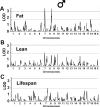Fat maintenance is a predictor of the murine lifespan response to dietary restriction
- PMID: 21388497
- PMCID: PMC3685291
- DOI: 10.1111/j.1474-9726.2011.00702.x
Fat maintenance is a predictor of the murine lifespan response to dietary restriction
Abstract
Dietary restriction (DR), one of the most robust life-extending manipulations, is usually associated with reduced adiposity. This reduction is hypothesized to be important in the life-extending effect of DR, because excess adiposity is associated with metabolic and age-related disease. Previously, we described remarkable variation in the lifespan response of 41 recombinant inbred strains of mice to DR, ranging from life extension to life shortening. Here, we used this variation to determine the relationship of lifespan modulation under DR to fat loss. Across strains, DR life extension correlated inversely with fat reduction, measured at midlife (males, r= -0.41, P<0.05, n=38 strains; females, r= -0.63, P<0.001, n=33 strains) and later ages. Thus, strains with the least reduction in fat were more likely to show life extension, and those with the greatest reduction were more likely to have shortened lifespan. We identified two significant quantitative trait loci (QTLs) affecting fat mass under DR in males but none for lifespan, precluding the confirmation of these loci as coordinate modulators of adiposity and longevity. Our data also provide evidence for a QTL previously shown to affect fuel efficiency under DR. In summary, the data do not support an important role for fat reduction in life extension by DR. They suggest instead that factors associated with maintaining adiposity are important for survival and life extension under DR.
© 2011 The Authors. Aging Cell © 2011 Blackwell Publishing Ltd/Anatomical Society of Great Britain and Ireland.
Figures







References
-
- Barzilai N. Author's response to commentary on “Revisiting the role of fat mass in the life extension induced by caloric restriction”. J Gerontol A Biol Sci Med Sci. 1999;54:B98. - PubMed
-
- Barzilai N, Gabriely I. The role of fat depletion in the biological benefits of caloric restriction. J Nutr. 2001;131:903S–906S. - PubMed
-
- Barzilai N, Gupta G. Revisiting the role of fat mass in the life extension induced by caloric restriction. J Gerontol A Biol Sci Med Sci. 1999;54:B89–96. discussion B97–88. - PubMed
Publication types
MeSH terms
Substances
Grants and funding
LinkOut - more resources
Full Text Sources
Other Literature Sources
Medical
Molecular Biology Databases

